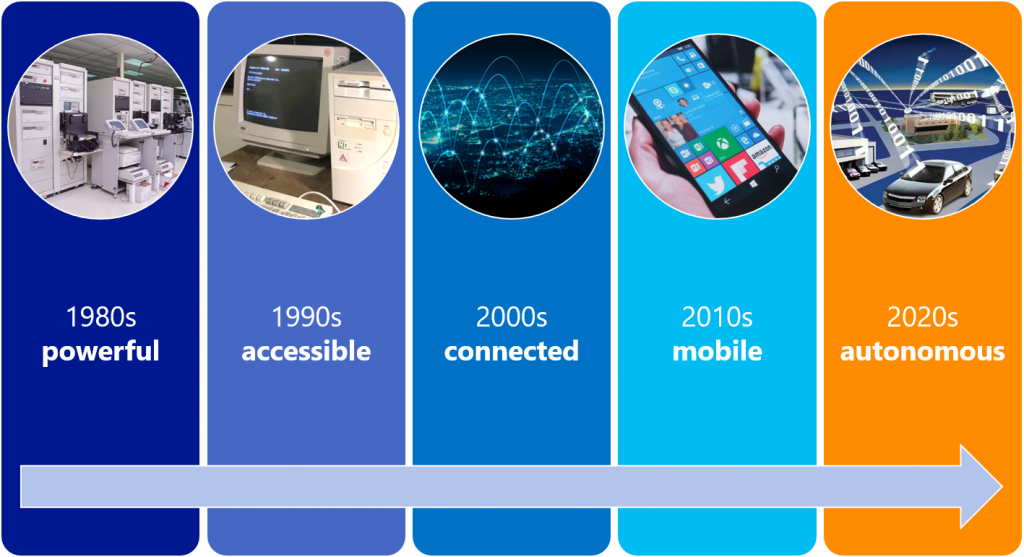By Ralph Haupter, President, Microsoft Asia. This article was originally posted on LinkedIn.
The business world is accelerating rapidly towards the 4th Industrial Revolution and technology is clearly in the driving seat. But that’s not all. It is stepping on the gas and not looking back in the rear-view mirror.
So, how are you positioning your company to stay competitive – not only in this current digital age, but also in the next?
It is a question that one of Microsoft’s most experienced Distinguished Engineers – and top technology evangelists – James Whittaker addressed during a recent tour of Asia. He concluded that when people look to the future, some “only see the present”. Many of us, it seems, have a blind spot when it comes to change and the fact that things just won’t stand still. Which is puzzling. After all, many of us have lived through several tech-led transitions over the years.
Remember the 1980s? That was an era of big “powerful” mainframe corporate computers. The 1990s saw the rise of the desktop PC. The 2000s was when the internet connected everyone. Each period replaced its preceding era with waves of change that we now take for granted.

Currently, we are in a decade of mobility and devices, and many of us in Asia have made the right digital transformation choices to meet these times. But don’t relax. Whittaker says we must get ready for the forthcoming “era of autonomy”.
In the 2020s, much of our world will be “reduced to data” that will be super-organized and integrated within the cloud. Innovations that are now in their infancy – the internet of things, machine learning, artificial intelligence, and so on – will start to mature and come of age. Digital disruption will affect every business, every organization, every industry, and every individual. And, it will come fast.
So how best to position ourselves for the near future? For the answer, I’ll stick to the theme of speed.
We’ve just enjoyed a string of exciting Grand Prix races across Asia – in Singapore, Malaysia, and Japan. Among the competitors was the Renault Sport Racing Formula One Team, which has ambitious plans to win the F1 Constructors’ Championship within three years. To achieve that goal, it needs more than just fast cars and daring drivers. It needs the right business applications and solutions to keep its digital transformation journey moving and evolving – not just for its racing crew, but also for the 1,000 or so people who design, test, and build its cars to unrelenting deadlines.
The Renault team has re-imagined itself as a digital business that is anchored in data and collaboration. Tailored solutions and applications have brought discipline to its highly technical factory production schedules and its business operations move along, on time and on budget. Crucially, it has partnered with Microsoft. And, that has opened new doors to the future by giving Renault access to the power of the cloud, artificial intelligence and even mixed reality with Microsoft HoloLens. By making the right data-driven technology choices now, Renault can expect to innovate, compete and win for years to come.
Renault’s story underscores how organizations today, irrespective of their industry or sector, need to think and act like digital enterprises. Digital transformation going forward requires building out what we refer to as “systems of intelligence” – digital feedback loops that help you better engage with your customers, empower your employees, optimize your operations, and reinvent products and business models. These systems of intelligence encompass your people, processes, and technology. They will ultimately define your competitiveness and ability to change the landscape of the industries in which you participate.
Now let’s look at the thorny issue of employment. As more and more industries feel the brunt of disruption, talk about job losses will inevitability increase in frequency and volume. That is totally understandable. But there is also another side to the jobs story: Digital solutions can help industries grappling with skilled labor shortages. Take for instance Japan, which is in a building and infrastructure boom ahead of the 2020 Tokyo Olympics as well as the 2027 opening of the Tokyo-Osaka Maglev high-speed train service. As the labor market gets tighter thanks to ageing demographics, the construction industry is starting to feel the pinch. So, coming up with labour-saving systems and greater automation, based on digital technology, is a top priority – both for the industry and the government.
One promising avenue is mixed reality, which uses data-driven holograms to combine the real and virtual worlds in front of a viewer’s eyes. The Oyanagi Construction Co. is pursuing “Holostruction”, a project that uses HoloLens with an array of other cloud-based technology to boost efficiencies across its operations – from design and planning, to works implementation, to contractor relations, to inspection. And, there is also materials and maintenance traceability – in other words, what’s been used and done, when and where, and how. The goal is to achieve more on building sites, faster and better, and with fewer workers. The company is about six decades old and its CEO Takuzo Oyanagi sees now as the point where it must keep transforming digitally to move ahead.
Greater productivity, though, is just one aspect of the digital revolution. The key to competitive success in the future will be the smart use of data across all aspects of a company to ultimately benefit customers.
For example, Silver Chain is one of the largest providers of personal healthcare services in Australia. They provide in-home care services for patients, following their recent discharge from hospital. Silver Chain needed to integrate multiple sources of data to create a single source of truth on the health and welfare of the patient, which is easily accessible by their teams across multiple devices and in real-time.
Naturally, given the sensitive nature of healthcare records, all this needed to be achieved with security, privacy and health industry compliance of paramount consideration.
I am pleased that they have chosen Microsoft’s Dynamics 365 to deliver these capabilities and are now experiencing improved patient care and greater employee productivity as a result.
Ultimately, we are rapidly moving towards a business era dominated by data. It is those organisations that are embracing digital technology to “connect the dots” of their various data silos and integrate it all with the back-end of the business operations that will win in this new era.
I wish you strong speed and good luck on your own digital transformation journey and, as always, welcome your comments and feedback.
Please click here for more articles written by Ralph Haupter






